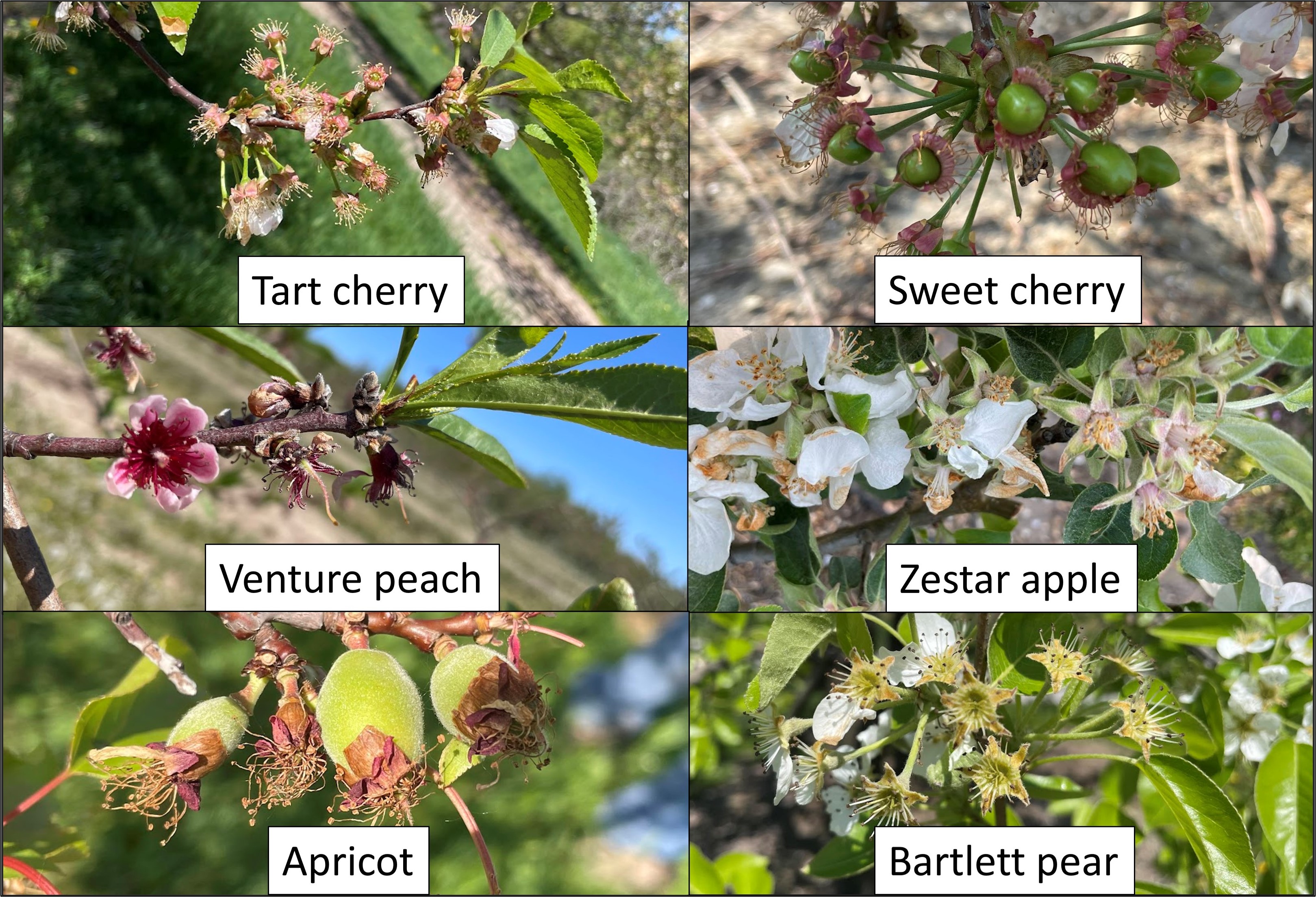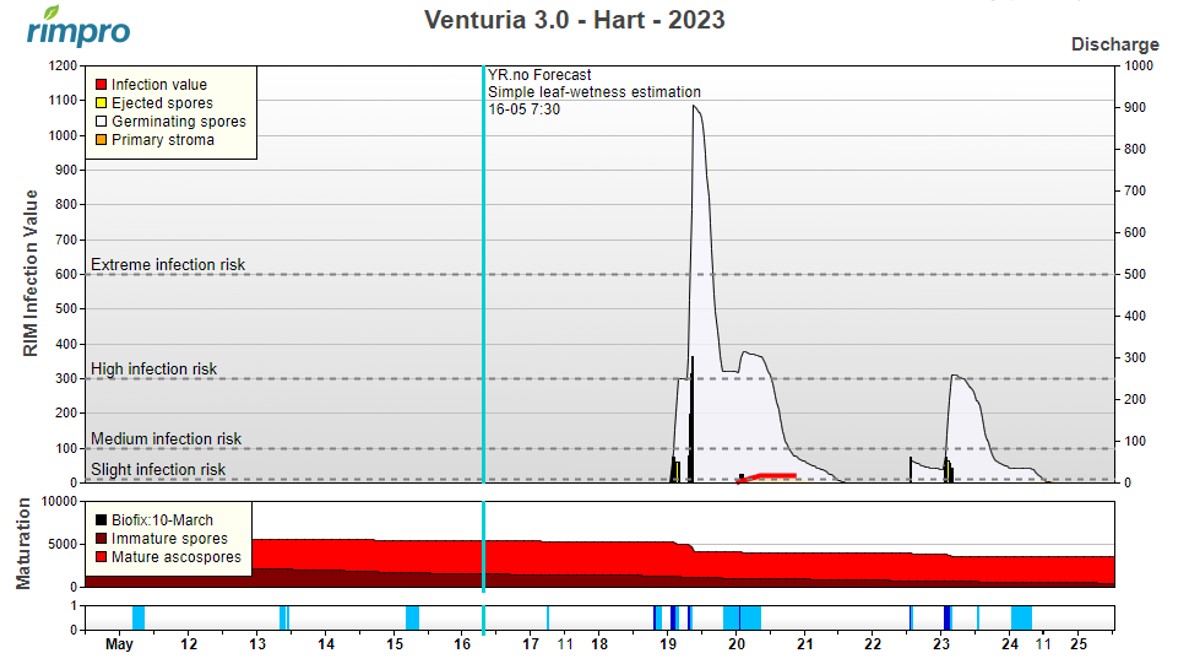West central Michigan tree fruit update – May 16, 2023
Early sweet cherry varieties are at shuck split while many apple varieties are in full bloom this week across the region.

Weather update
Warm weather last week rapidly advanced tree phenology, and many apple and pear varieties were in full bloom across west central Michigan (Photo 1). Some early sweet cherry varieties are at fruit set, and tart cherries, early apple varieties and pear are almost at petal fall (Photo 2). Based on the Hart Enviroweather station for May 16, current growing degree day (GDD) accumulation is 444 GDD42 and 228 GDD50. Across the region, GDD accumulation is currently above the five-year average (Table 1).
There have been dips in temperatures the past few nights with lows in the 30s and daytime highs in the 60s. Temperatures will remain cooler this week and into next week with highs in the 60s and lows in the 40s.
Rain showers occurred on Saturday, May 13, which led to a 3-hour wetting event with only 0.11 inches of rain in Hart, according to Enviroweather. Dry and sunny conditions are forecasted for this week. Light rain is forecasted this Friday, May 19, in the west central region. Weather for the 8-14 day outlook is expected to be warmer and drier than normal.
|
Table 1. Current and five-year average GDD summary from March 1- May 16. Numerical integration was used for degree day calculations. |
||||
|---|---|---|---|---|
|
Station |
2022 GDD Base 42 F |
5-yr Avg GDD Base 42 F |
2022 GDD Base 50 F |
5-yr Avg GDD Base 50 F |
|
Benona/Shelby |
405 |
301 |
207 |
125 |
|
Elbridge/Hart |
428 |
352 |
227 |
158 |
|
Fremont |
451 |
391 |
237 |
180 |
|
Grant |
461 |
404 |
244 |
187 |
|
Hart |
432 |
340 |
226 |
149 |
|
Ludington |
414 |
328 |
214 |
142 |
|
Mears |
425 |
372 |
222 |
165 |
|
New Era |
432 |
354 |
225 |
149 |
Weather data was gathered from Enviroweather.
More information and reports on normal weather conditions and departures from normal can be found on the NOAA Climate Prediction Center website, NOAA U.S. Climate Normals website, NOAA Climate Normals Quick Access Page (which may be searched by region) and Midwest Regional Climate Center website.
Watch the full weather outlook from MSU meteorologist Jeff Andresen.
Crop update

Cool weather will extend bloom this week for some varieties. With an extended bloom, consider how to protect and support native and commercial bees. Delay spraying until bloom is over to prevent risk to pollinators. If there is pest and disease pressure during bloom that reaches economic thresholds, you may need to spray to protect the crop. Rufus Isaacs and Julianna Wilson from Michigan State University recommend reducing risk to pollinators by applying pesticides that are 1) allowed for use during bloom and 2) have the lowest toxicity to bees. Apply pesticides when bees are not actively foraging and when conditions are unlikely to cause drift. Bumble bees and honey bees can travel a few miles to forage on crop and non-crop flowers. To reduce honey bee pesticide exposure risk within the orchard after petal fall, growers can mow flowers off attractive ground covers.
Some growers are root pruning Honeycrisp and other apple tree varieties on vigorous rootstocks. Root pruning is recommended to be done at bloom and up to two weeks after bloom from 1 - 4 feet from the trunk. Root pruning closer to the trunk has a more dramatic effect than root pruning farther away from the trunk. More information about root pruning can be found in the Michigan State University Extension article, “Root pruning guide for apple trees to reduce excessive vigor.” Root pruning has been shown to reduce tree vigor, shoot growth and fruit size which may help minimize bitter pit development in Honeycrisp.
Apple varieties in the west central region range from bloom to petal fall. Early varieties such as Zestar and Idared are at petal fall. Later varieties such as Gala and Honeycrisp are at the end of full bloom. Hart is at 444 GDD42 and 228 GDD50. Consider thinning fruit early, starting with blossom thinning this year. Trees have more blooms than expected considering the heavy crop load in 2022. Blossom thinning is particularly beneficial for varieties that initiate flower bud formation early (in June and July) for the following season such as Honeycrisp, Minneiska, Macoun, Fuji and Golden Delicious. In a Cornell University study, blossom thinning increased return bloom more than thinning at the 10-12 mm stage in Honeycrisp and Fuji.
For more thinning recommendations, growers can access the MSU Thinning Guide.
Specific information on thinning strategies for Honeycrisp can be found in this article Honeycrisp Crop Management for 2022.
Tart and sweet cherry buds range from petal fall to shuck split. Early varieties of sweet cherries are at fruit set, and fruitlets are over 5 mm in diameter.
Peach buds range from bloom to petal fall. Some early fresh market varieties are at shuck split. Venture peach at the West Central Michigan Research and Extension Center is at petal fall.
Pear varieties range from bloom to petal fall. Bartlett pear at the West Central Michigan Research and Extension Center is almost at petal fall.
Pest and disease update
In the west central region, pest activity is starting to rise. Consider your scouting reports and block history to target hot spots for early season pests in the orchard according to growth stage. Note that codling moth has not been trapped yet but biofix is predicted later this week.
Early season pests
Black stem borer adults are active in warmer temperatures. Trapping near woodlots or injured trees is recommended to monitor for flight of females.
European red mite is active in warm and dry conditions, which are favorable for egg hatch and larvae activity. Scout for European red mites in apple and pear.
Obliquebanded leafroller is predicted to have sustained catch in late May/early June due to the cooler weather this week. Sustained catch is expected at 900 GDD42. Scout orchard blocks in a few weeks to determine if a spray is needed. Consider Bt sprays in problem blocks.
Oriental fruit moth was caught again this week with a spike in moths trapped of 54 moths per trap. Biofix 1 is estimated to have occurred on May 9. Traps and lures should be placed in orchards now. Be sure to scout orchards and problem blocks. According to the Enviroweather model for oriental fruit moth, first generation eggs were laid on May 13. Peak adult emergence is predicted to be on May 21, and treatment will be needed at that timing for petal fall or shuck split applications depending on the variety.
Pear psylla is commonly found in our region. Scout for adults and newly laid eggs at this stage. Early management is key to keeping damage thresholds low through the season.
Redbanded leafroller adult flight is present in the region with an average of 33 adults per trap. Continue to monitor this minor tree fruit pest.
Rosy apple aphid is a common pest in our region and will be present soon. Scout for colonies of dark purple nymphs in fruit clusters and treat blocks as needed.
San Jose scale are now present in some orchards in the region. Monitor in blocks where scales were present on fruit in 2022. San Jose scale may feed on apple, pear, plum, apricot and sweet cherry. Adults will be flying and can be treated with Movento.
Spotted tentiform leafminer activity may be low this week due to cooler temperatures. Adults have been trapped in low numbers in the region. Larvae that feed on sap of leaves may not be present for one or two more weeks.
Disease update
Apple scab: The RIMPro forecast is predicting a slight infection risk for apple scab on May 20 (Photo 3). A wetting event is forecasted on May 19, and spores will be released. Because of cooler temperatures, spore germination and growth will be slow. With stretches of warmer weather, there has been a lot of new growth and new leaf tissue, so it is important to protect that new growth with adequate fungicide coverage. Coverage will also be important for pear blocks in the region for pear scab (Venturia pirina). In general, spore release and infection risk to date has been low this season.

Powdery mildew: Warm temperatures and high humidity this week may result in powdery mildew infection. Powdery mildew is caused by the fungus Podosphaera leucotricha. Powdery mildew has been reported in the Grand Rapids area and southeast Michigan. It affects cherries, apples and pears and causes infections on the underside of the leaf that lead to chlorotic patches or spots on the upper side of the leaf. It is important to manage powdery mildew because infected blossoms can cause poor fruit set or stunted and russetted fruit. Note that sterol inhibitors, strobilurins and succinate dehydrogenase inhibitors control powdery mildew. Captan, Scala, Vangard and EBDC fungicides will not control powdery mildew. Spray for powdery mildew from tight cluster or bloom through midsummer.
Cherry leaf spot: Tart cherry growers should begin cherry leaf spot management programs if they have not already. Management programs target the cherry leaf spot fungus, Blumeriella jaapii. Friday, May 19, is a predicted infection period with forecasted rainfall. New green tissue should be protected prior to rain events.
Fire blight: There was a fire blight infection period on Saturday, May 13. It will be important for west central growers to manage fire blight as blossom blight and shoot blight this year, particularly in young, high-density plantings. Apples are in full bloom across the region, and it is important for growers to keep blossoms protected once they open. If trees are still in bloom at the end of the week, there is another anticipated infection period this Friday, May 19, with the forecasted rain. As trees advance to fruit set, continue an active fire blight management program and target shoot blight with the Apogee and Actigard in combination.
American brown rot: To manage American brown rot in cherry and peach, apply fungicides at petal fall and shuck split. Warm and wet conditions favor development of the American brown rot pathogen, Monolinia fructicola, in cherry and peach. Since rainfall has been limited, American brown rot pressure at the blossom stage has been generally low; however, consider American brown rot management, particularly in blocks where brown rot has been a problem historically.
For pest and disease management recommendations, please refer to Fruit Management Guide (E-154) for product guidelines.
For more information about regional reports, please visit the Michigan State University Extension website.



 Print
Print Email
Email

